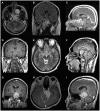Integrated Anterior, Central, and Posterior Skull Base Unit - A New Perspective
- PMID: 26258128
- PMCID: PMC4508483
- DOI: 10.3389/fsurg.2015.00032
Integrated Anterior, Central, and Posterior Skull Base Unit - A New Perspective
Abstract
The skull base is one of the most complex anatomical regions and forms the floor of the cranial cavity. Skull base surgery involves open, microscopic, and endoscopic approaches to the anterior, middle, or posterior cranial fossa. A multispecialty team approach is essential in treating patients with skull base lesions. Traditionally, rhinologists are involved in providing access to anterior skull base lesions while otologists are involved in the treatment of lesions of the posterior skull base. This is the case in most skull base centers today. In this article, we share a new perspective of an integrated skull base unit where a team of otolaryngologists and neurosurgeons treat anterior, middle, and posterior skull base pathologies. The rationale for this approach is that most technical skills required in skull base surgery are interchangeable and apply whether an endoscopic or microscopic approach is used. We show how the different skills apply to the different approaches and share our experience with an integrated skull base unit.
Keywords: anterior skull base; central skull base; extended endoscopic endonasal approaches; lateral skull base; neurotology; skull base surgery.
Figures

References
Publication types
LinkOut - more resources
Full Text Sources
Other Literature Sources

